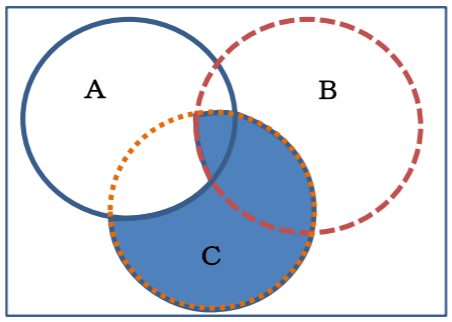Secret Investigation
The secretive organization AiZu AnalyticS has launched a top-secret investigation. There are N persons being targeted, and they are assigned identification numbers from 1 to N. As an information strategy researcher, you decide to determine the number of persons among the targets who meet at least one of the following conditions.
- A person who does not belong to organization $A$ and possesses product $C$.
- A person who belongs to organization $B$ and possesses product $C$.
Write a program which reads the identification numbers of a person who belongs to organization $A$, a person who belongs to organization $B$, and a person who possesses product $C$ and determines the number of persons who satisfy the conditions. However, be careful not to duplicate the number of persons who satisfy both conditions.
(Supplement: About the above condition)
Let $A$, $B$, and $C$ be the sets of some elements from the set of natural numbers from $1$ to $N$. The number of persons satisfying the condition is the number of elements satisfying $(\bar{A} \cap C) \cup (B \cap C)$ (the shaded area in the figure). Note that $\bar{A}$ is the complement of the set $A$.

Input
The input is given in the following format.
N X a1 a2 ... aX Y b1 b2 ... bY Z c1 c2 ... cZ
The input consists of 4 lines, The number of persons to be surveyed N (1 ≤ N ≤ 100) is given in the first line. On the second line, the number of persons belonging to the organization $ A $ X (0 ≤ X ≤ N ) and then the identification numbers of the person who belongs to the organization $ A $ a i (1 ≤ a i ≤ N ) are given. On the third line, the number of persons belonging to the organization $ B $ Y (0 ≤ Y ≤ N ) and then the identification numbers of the person who belongs to the organization $ B $ b i (1 ≤ b i ≤ N ) are given. On the fourth line, the number of persons who have the product $ C $ Z (0 ≤ Z ≤ N ), following that, the identification numbers of the person who have the product $ C $ c i (1 ≤ c i ≤ N ) is given.
Output
Output the number of persons who satisfy the condition on a single line.
Sample Input 1
5 3 1 2 3 2 4 5 2 3 4
Sample Output 1
1
Sample Input 2
100 3 1 100 4 0 2 2 3
Sample Output 2
2